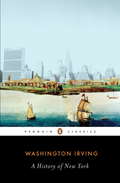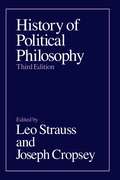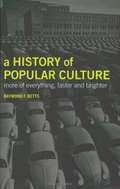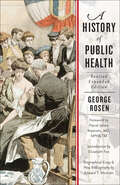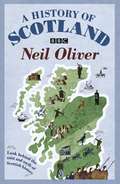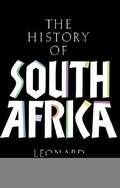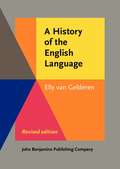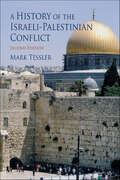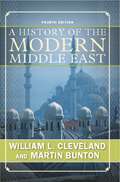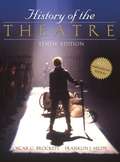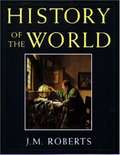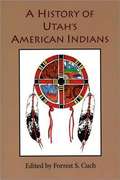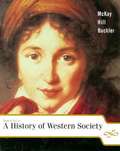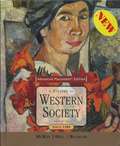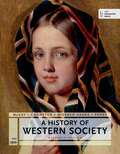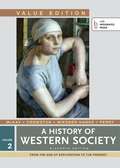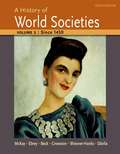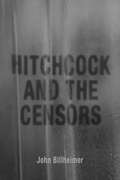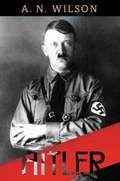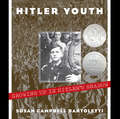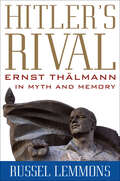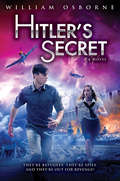- Table View
- List View
A History of New Mexico (3rd Revised Edition)
by Susan A. Roberts Calvin A. RobertsMOST OF YOU READING THESE WORDS LIVE in the state of New Mexico. Some of you were born here. Others of you moved here from some other place. As New Mexicans, you already know something about your state. You know most, of course, about the area in which you live. But New Mexico covers a large area. It is a land in which different peoples have developed different ways of living. To learn more about the land and its people, you will need to study the history of New Mexico.
A History of New York
by Washington IrvingPurchase of this book includes free trial access to www. million-books. com where you can read more than a million books for free. This is an OCR edition with typos. Excerpt from book: BOOK I. CONTAINING DIVERS INGENIOUS THEORIES AVD PHILOSOPHIC SPECULATIONS, CONCERNING THE CREATION AND POPULATION OF THE WORLD, AS CONNECTED WITH THE HISTORY OF NEW-YORK. CHAPTER I. Description of the World. According to the best authorities, theworld iu which we dwell is a huge, opaque, reflecting, inanimate mass, floating in the vast ethereal ocean of infinite space. It has the form of an orange, being an oblate spheroid, curiously flattened at opposite parts, for the insertion of two imaginary poles, which are supposed to penetrate and unite at the centre; thus forming an axis on which the mighty orange turns with a regular diurnal revolution. The transitions of light and darkness, whence proceed the alternations of day and night, are produced by this diurnal revolution successively pre- 32 DERSCRIPTION OF THE WORLD. tenting the different parts of the earth to the rays of the sun. The latter is, according to the best, that is to say, the latest accounts, a luminous or fiery body, of a prodigious magnitude, from which this world is driven by a centrifugal or repelling power, and to which it is drawn by a centripetal or attractive force; otherwise called the attraction of gravitation; the combination, or rather the counteraction of these two opposing impulses pBoducing a circular and annual revolution. Hence result the different seasons of the year, viz. spring, summer, autumn, and winter. This I believe to be the most approved modern theory on the subject?though there be many philosophers who have entertained very different opinions; some, too, of them entitled to much deference from their great antiquity and illustrious characters. Thus it was advanced by some of the ancient sages, that the earth was an extended plain, supported by vast pillars; and by . . .
History of Political Philosophy (Third Edition)
by Leo Strauss Joseph CropseyWritten by specialists on the various philosophers, this third edition has been expanded significantly to include both new and revised essays.
A History of Popular Culture: More of Everything, Faster, and Brighter
by Raymond F. BettsThis lively and informative survey provides a thematic global history of popular culture focusing on the period since the end of the Second World War. Raymond Betts considers the rapid diffusion and "hybridization" of popular culture as the result of three conditions of the world since the end of World War Two: instantaneous communications, widespread consumption in a market-based economy and the visualization of reality. Betts considers the dominance of American entertainment media and habits of consumption, assessing adaptation and negative reactions to this influence. The author surveys a wide range of topics, including the effects of global conflict, the effects of urbanization and the growth of sport as a commercial enterprise.
A History of Public Health
by George RosenGeorge Rosen's wide-ranging account of public health's long and fascinating history is an indispensable classic.Since publication in 1958, George Rosen's classic book has been regarded as the essential international history of public health. Describing the development of public health in classical Greece, imperial Rome, England, Europe, the United States, and elsewhere, Rosen illuminates the lives and contributions of the field's great figures. He considers such community health problems as infectious disease, water supply and sewage disposal, maternal and child health, nutrition, and occupational disease and injury. And he assesses the public health landscape of health education, public health administration, epidemiological theory, communicable disease control, medical care, statistics, public policy, and medical geography.Rosen, writing in the 1950s, may have had good reason to believe that infectious diseases would soon be conquered. But as Dr. Pascal James Imperato writes in the new foreword to this edition, infectious disease remains a grave threat. Globalization, antibiotic resistance, and the emergence of new pathogens and the reemergence of old ones, have returned public health efforts to the basics: preventing and controlling chronic and communicable diseases and shoring up public health infrastructures that provide potable water, sewage disposal, sanitary environments, and safe food and drug supplies to populations around the globe.A revised introduction by Elizabeth Fee frames the book within the context of the historiography of public health past, present, and future, and an updated bibliography by Edward T. Morman includes significant books on public health history published between 1958 and 2014. For seasoned professionals as well as students, A History of Public Health is visionary and essential reading.
A History Of Scotland: Look Behind The Mist And Myth Of Scottish History
by Neil OliverThe dramatic story of Scotland - by charismatic television historian, Neil Oliver.Scotland is one of the oldest countries in the world with a vivid and diverse past. Yet the stories and figures that dominate Scottish history - tales of failure, submission, thwarted ambition and tragedy - often badly serve this great nation, overshadowing the rich tapestry of her intricate past.Historian Neil Oliver presents a compelling new portrait of Scottish history, peppered with action, high drama and centuries of turbulence that have helped to shape modern Scotland. Along the way, he takes in iconic landmarks and historic architecture; debunks myths surrounding Scotland's famous sons; recalls forgotten battles; charts the growth of patriotism; and explores recent political developments, capturing Scotland's sense of identity and celebrating her place in the wider world.
The History of South Africa
by Leonard Monteath ThompsonA leading scholar of South Africa provides a fresh and penetrating exploration of that country's history from the earliest known human habitation to the present, focusing primarily on the experiences of its black inhabitants.
A History of the English Language (Revised Edition)
by Elly Van GelderenThe English language in its complex shapes and forms changes fast. This thoroughly revised edition has been refreshed with current examples of change and has been updated regarding archeological research. Most suggestions brought up by users and reviewers have been incorporated, for instance, a family tree for Germanic has been added, Celtic influence is highlighted much more, there is more on the origin of Chancery English, and internal and external change are discussed in much greater detail. The philosophy of the revised book remains the same with an emphasis on the linguistic history and on using authentic texts. My audience remains undergraduates (and beginning graduates). The goals of the class and the book are to come to recognize English from various time periods, to be able to read each stage with a glossary, to get an understanding of typical language change, internal and external, and to understand something about language typology through the emphasis on the change from synthetic to analytic. This book has a companion website: http://dx. doi. org/10. 1075/z. 183. website
A History of the Israeli-Palestinian Conflict
by Mark TesslerMark Tessler's highly praised, comprehensive, and balanced history of the Israeli-Palestinian conflict from the earliest times to the present—updated through the first years of the 21st century—provides a constructive framework for understanding recent developments and assessing the prospects for future peace. Drawing upon a wide array of documents and on research by Palestinians, Israelis, and others, Tessler assesses the conflict on both the Israelis' and the Palestinians' terms. New chapters in this expanded edition elucidate the Oslo peace process, including the reasons for its failure, and the political dynamics in Israel, the West Bank, and Gaza at a critical time of transition.
A History of the Modern Middle East
by ClevelandThis comprehensive work provides a penetrating analysis of modern Middle Eastern history, from the Ottoman and Egyptian reforms, through the challenge of Western imperialism, to the Iranian Revolution and the recent Gulf War. <P><P> After introducing the reader to the region's history from the origins of Islam in the seventh century, Cleveland focuses on the past two centuries of profound and often dramatic change. While built around a framework of political history, the book also carefully integrates social, cultural, and economic developments into a single, carefully crafted account. Cleveland sets the stage with a superb, concise overview of the long-term, general patterns of Middle Eastern history. The book opens with a portrayal of Islam that stresses an understanding of this great world religion and culture on its own terms and in its specific historical setting. The rich potential of this culture manifested itself in shifting centers of Islamic florescence, culminating in the rise of the Ottoman and Safavid Empires as the central political and social entities of the Middle East in the sixteenth through the eighteenth centuries. The book next examines the crucial developments of the nineteenth century-an era characterized by attempts at the self-transformation of Middle Eastern societies, a process sometimes misleadingly referred to as "modernization" or "Westernization. " The resulting disruption of the established order was a wrenching and disorienting experience for the peoples of the region. Defeat in World War I delivered the coup de grace to Ottoman rule and brought in the "mandate system" through which the British and the French sought to impose their overlordship on the Arab world. The interwar years, through to the end of World War II, were characterized by the Arab struggle for independence. This struggle led to the emergence of the major political ideologies of the Arab world-regionalism, pan-Arab nationalism-combined with the enduring appeal of Islamic solidarity. During this same period the two major independent states of the region, Turkey and Iran, embarked on intensive programs of secular reform designed to remake their societies in the image of the West. Several Arab states were able to establish their independence, but this process was greatly complicated by the legacies of European rule, especially the founding of the state of Israel in 1948 and the cold war rivalry of the superpowers. Many of the problems faced in the region today are a direct consequence of this historical legacy: the Arab-Israeli conflict, the concentration of oil wealth into the hands of a few, the Iran-Iraq war, the Palestinian problem, the dissolution of Lebanon, Islamic fundamentalism, and the striving for power on the world stage of states such as Syria, Iraq, and Iran. A History of the Modern Middle East explains the deep historical currents flowing beneath today's headlines, making it essential reading for anyone seeking a better understanding of today's turbulent world.
History of the Northern Mariana Islands
by Don A. FarrellHistory textbook about the Northern Mariana Islands
History Of the Theatre (Tenth Edition)
by Oscar G. Brockett Franklin J. HildyKnown as the "bible" of theatre history, Brockett and Hildy's History of the Theatre is the most comprehensive and widely used survey of theatre history in the market. This 40th Anniversary Edition retains all of the traditional features that have made History of the Theatre the most successful text of its kind, including worldwide coverage, more than 530 photos and illustrations, useful maps, and the expertise of Oscar G. Brockett and Franklin J. Hildy, two of the most widely respected theatre historians in the field. As with every edition, the text reflects the current state of knowledge and brings the history of theatre up to the present. This tenth edition continues to provide the most thorough and accurate assessment of theatre history available.
A History of the United States
by Daniel J. Boorstin Brooks Mather Kelley Ruth Frankel BoorstinA text on the history of the United States through 1998.
A History of the World
by J. M. RobertsFrom the evolution of Homo Sapiens to the exploration of space, the vast landscape of human history appears in this authoritative, readable book. Evocatively illustrated, this work offers an outstanding one-volume survey of the major events, developments, and personalities of the known past. Illus. Maps.
A History of Utah's American Indians
by Forrest S. CuchThis book is a joint project of the Utah Division of Indian Affairs and the Utah State Historical Society. It is distributed to the book trade by Utah State University Press. The valleys, mountains, and deserts of Utah have been home to native peoples for thousands of years. Like peoples around the word, Utah's native inhabitants organized themselves in family units, groups, bands, clans, and tribes. Today, six Indian tribes in Utah are recognized as official entities. They include the Northwestern Shoshone, the Goshutes, the Paiutes, the Utes, the White Mesa or Southern Utes, and the Navajos (Dineh). Each tribe has its own government. Tribe members are citizens of Utah and the United States; however, lines of distinction both within the tribes and with the greater society at large have not always been clear. Migration, interaction, war, trade, intermarriage, common threats, and challenges have made relationships and affiliations more fluid than might be expected. In this volume, the editor and authors endeavor to write the history of Utah's first residents from an Indian perspective. An introductory chapter provides an overview of Utah's American Indians and a concluding chapter summarizes the issues and concerns of contemporary Indians and their leaders. Chapters on each of the six tribes look at origin stories, religion, politics, education, folkways, family life, social activities, economic issues, and important events. They provide an introduction to the rich heritage of Utah's native peoples. This book includes chapters by David Begay, Dennis Defa, Clifford Duncan, Ronald Holt, Nancy Maryboy, Robert McPherson, Mae Parry, Gary Tom, and Mary Jane Yazzie. Forrest Cuch was born and raised on the Uintah and Ouray Ute Indian Reservation in northeastern Utah. He graduated from Westminster College in 1973 with a bachelor of arts degree in behavioral sciences. He served as education director for the Ute Indian Tribe from 1973 to 1988. From 1988 to 1994 he was employed by the Wampanoag Tribe in Gay Head, Massachusetts, first as a planner and then as tribal administrator. Since October 1997 he has been director of the Utah Division of Indian Affairs.
A History of Western Society (7th edition)
by John Buckler Bennett D. Hill John P. MckayMcKay (History, U. of Illinois at Urbana-Champaign) offers a history of western civilization from Mesopotamia to the present, with a focus on social history and chapters on Greece, Rome, religious wars, political revolutions, revolutions in energy and industry, expansion, urbanism, nationalism, dictatorship and the Second World War, and the Cold War, among other topics. The new edition is updated with recent scholarship, primary sources, photo essays, information on women and gender, and more focus on ethnicity such as with the section on Islamic regions.
A History of Western Society Since 1300 (Advanced Placement Edition)
by John P. Mckay Bennett D. Hill John BucklerA History of Western Society Since 1300 Textbook
A History Of Western Society Since 1300 for AP 11th Ed
by John P. Mckay Bennett D. Hill John Buckler Clare Haru Crowston Merry E. Wiesner-Hanks Joe PerryA History of Western Society continues to capture the attention of AP European history students because it recreates the lives of ordinary people and makes history memorable. The eleventh edition continues to tie social history to the broad sweep of politics and culture, heightening its attention to daily life, and aligning perfectly to the AP European course. With its unique AP-specific features and resources, and a variety of new digital tools, A History of Western Society helps AP students master the concepts and content of European history, whether in print or online.
A History Of Western Society Volume 2: From the Age of Exploration to the Present
by John P. Mckay Bennett D. Hill John Buckler Clare Haru Crowston Merry E. Wiesner-Hanks Joe PerryThe lively and accessible narrative and the hallmark focus on social and cultural history that has made A History of Western Society one of the most successful textbooks for the Western civilization course.
A History Of World Societies Volume 2 Since 1450
by John P. Mckay Patricia Buckley Ebrey Roger B. Beck Clare Haru Crowston Merry E. Wiesner-Hanks Jerry Davila Bennett D. Hill John BucklerLong praised by instructors and students for its accessible regional chapter structure, readability, and sustained attention to social history, the tenth edition of A History of World Societies includes even more built-in tools to engage today's students and save instructors time. This edition features thoroughly revised chapters by new author and Latin American specialist Jerry Dávila, an expanded primary source program in the text and online, and the best and latest scholarship throughout.
Hitchcock and the Censors (Screen Classics)
by John BillheimerThroughout his career, Alfred Hitchcock had to deal with a wide variety of censors attuned to the slightest suggestion of sexual innuendo, undue violence, toilet humor, religious disrespect, and all forms of indecency, real or imagined. From 1934 to 1968, the Motion Picture Production Code Office controlled the content and final cut on all films made and distributed in the United States. Code officials protected sensitive ears from standard four-letter words, as well as a few five-letter words like tramp and six-letter words like cripes. They also scrubbed "excessively lustful" kissing from the screen and ensured that no criminal went unpunished.During their review of Hitchcock's films, the censors demanded an average of 22.5 changes, ranging from the mundane to the mind-boggling, on each of his American films. Code reviewers dictated the ending of Rebecca (1940), absolved Cary Grant of guilt in Suspicion (1941), edited Cole Porter's lyrics in Stage Fright (1950), decided which shades should be drawn in Rear Window (1954), and shortened the shower scene in Psycho (1960).In Hitchcock and the Censors, author John Billheimer traces the forces that led to the Production Code and describes Hitchcock's interactions with code officials on a film-by-film basis as he fought to protect his creations, bargaining with code reviewers and sidestepping censorship to produce a lifetime of memorable films. Despite the often-arbitrary decisions of the code board, Hitchcock still managed to push the boundaries of sex and violence permitted in films by charming -- and occasionally tricking -- the censors and by swapping off bits of dialogue, plot points, and individual shots (some of which had been deliberately inserted as trading chips) to protect cherished scenes and images. By examining Hitchcock's priorities in dealing with the censors, this work highlights the director's theories of suspense as well as his magician-like touch when negotiating with code officials.
Hitler
by A. N. WilsonA ruthless dictator who saved his country from economic ruin only to nearly destroy it#151;and an entire people#151;in his quest for world domination, Adolf Hitler forever changed the course of history. In this masterful account of Hitler’s life, biographer A. N. Wilson pulls back the curtain to reveal the man behind the mythic figure, shedding new light on Hitler’s personality, his desires, and his complex relationship with the German people. While Hitler maintained that his life had been characterized by #147;struggle” from its very beginnings, Wilson shows that the reality could not have been more different. Hitler grew up in middle-class comfort and, as a young man, lacked ambitions of any sort besides a vaguely bohemian desire to become an artist. And while the Hitlerian mythos holds that he forged his skills as a leader during the First World War, Wilson explains the truth: Hitler spent most of the war as an office boy miles from the front lines, and only received his cherished Iron Cross because of his slavishness to the officers he served. The army gave him a sense of purpose and brotherhood, however, which continued to inspire Hitler once the war ended. Hitler left the army with no skills, contacts, or money#151;and yet, within fourteen years, he would become chancellor of the German nation. Wilson describes the story of Hitler’s ascent as one of both opportunism and sheer political shrewdness. He possessed no real understanding of the workings of government but had a prodigious knack for public speaking, and found that a large number of Germans, despairing at their country’s recent defeat and terrified by the specter of international communism, were willing to listen to the right-wing fantasies that had taken root inside his head. Allying himself with the extremist German Workers’ Party (soon renamed the National Socialist Party), Hitler offered many Germans a seductive vision of how the country might raise itself back up and reclaim its rightful place at the center of world politics. Wilson shows that, although Hitler’s bid for power stalled at first, he soon gained traction with a German public starved for hope. Using his skills as a manipulator, Hitler found himself first at the head of the Nazi Party, then at the helm of the German nation. Wilson explores the forces that allowed Hitler to become Chancellor of Germany, and later to march Germany into total war. He examines Hitler’s increasingly virulent anti-Semitism and his decision to implement the Final Solution to exterminate European Jews, and he considers Hitler’s tactical successes#151;and failures#151;in World War II. Wilson also reveals a great deal about how Hitler’s personal life affected his time as Germany’s leader, from the lasting pain caused by the death of his mother and the suicide of his young niece to his poor health and addiction to the drugs prescribed by his doctor. As Wilson demonstrates, Hitler the Führer was not so different from Hitler the bohemian: lazy, moody, and hypersensitive, he ruled more through intimidation and the mystifying force of his personality than through any managerial skill or informed decision-making. His story#151;and that of Germany#151;is ultimately a cautionary tale. In a modern era enamored with progress, rationality, and modernity, it is often the darkest and most chaotic elements of society that prove the most seductive. Hitler’s unlikely rise to power and his uncanny ability to manipulate his fellow man resulted in the deaths of millions of Europeans and a horrific world war, yet despite his colossal role in world history, he remains mythologized and, as a result, misunderstood. In Hitler, A. N. Wilson limns this mysterious figure with great verve and acuity, showing that it was Hitler’s frightening normalcy#151;not some otherworldly evilness#151;that makes him so truly terrifying.
Hitler Youth (Scholastic Focus): Growing Up in Hitler's Shadow
by Susan Campbell BartolettiRobert F. Sibert Award-winner Susan Campbell Bartoletti explores the riveting and often chilling story of Germany's powerful Hitler Youth groups.In her first full-length nonfiction title since winning the Robert F. Sibert Award, Susan Campbell Bartoletti explores the riveting and often chilling story of Germany's powerful Hitler Youth groups."I begin with the young. We older ones are used up . . . But my magnificent youngsters! Look at these men and boys! What material! With them, I can create a new world." --Adolf Hitler, Nuremberg 1933 By the time Hitler became Chancellor of Germany in 1933, 3.5 million children belonged to the Hitler Youth. It would become the largest youth group in history. Susan Campbell Bartoletti explores how Hitler gained the loyalty, trust, and passion of so many of Germany's young people. Her research includes telling interviews with surviving Hitler Youth members.
Hitler's Rival: Ernst Thälmann in Myth and Memory
by Russel LemmonsThroughout the 1920s, German politician and activist Ernst Thälmann (1886–1944) was the leader of the largest Communist Party organization outside the Soviet Union. Thälmann was the most prominent left-wing politician in the country's 1932 election and ra
Hitler's Secret
by Will Osborne William Osborne"An incredible adventure and a great page-turner!" -- Bear GryllsOtto and Leni thought they were safe: They escaped -- barely -- from war-torn Europe and are living as refugees in England. But now the Crown has recruited them: Great Britian wants them to go back. As spies!Dropped behind enemy lines, they embark on a top-secret operation. Code name: Wolfsangel. Their mission? Capture the one person who can defeat the ultimate evil of Nazism! Der Fuhrer has destroyed Otto's and Leni's families, but what if the tables were turned? What if Hitler's ultimate legacy was in their hands?Breathless pacing, nonstop action: By the screenwriter of Goldeneye, HITLER'S SECRET is a cinematic tale of revenge with an unexpected twist. A note by the author explains the truth behind the fiction and lets readers know what really became of history's greatest villains.

